March 23rd, 2014 §
For historical record it’s worth noting that last weekend I said goodbye to Griz, the rooster hatched last summer from a well-traveled egg. Griz had been up on CraigsList for months, for free, after he predictably began challenging his father, Calabrese, in bloody fights for control of the hens. I’d separated Griz on his own in a garage coop and left him to await his fate.
Here he is on the way to his new life. He turned out to have the Cuckoo Marans coloration of his olive egger mother but the green and gold feathers came from Calabrese, his Wheaten Ameraucana father.
It’s a funny thing that he got his name from my brother, who I gave naming honors because Griz’s egg spent time in my brother’s refrigerator before being recalled to Free Union to hatch. My brother chose Grizabella as the name for this chick, which when he turned out to be a cockerel I shortened to Griz. Just the other day I was reading some British magazines and learned that “grizzly” is a term used in that part of the world to describe a chicken of this black and white barred feather patterning—something I’d never heard in America. Weird coincidence, huh?
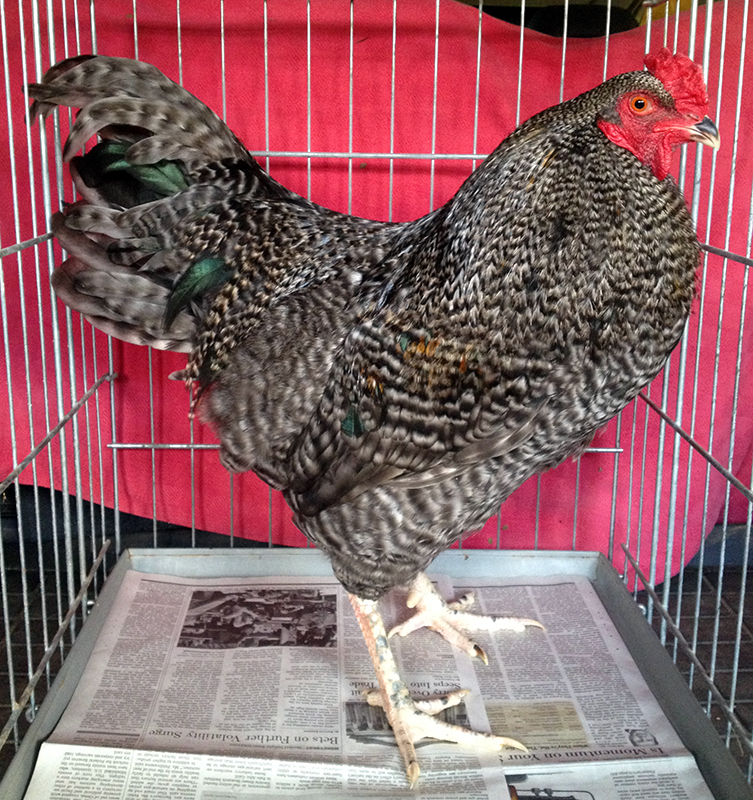
I am happy to report that Griz has gone on to a new family, who kept his name, and a flock of his own, along with a dozen of my hatching eggs. Part of the Bonafide flock will live on now in Madison, VA.
I got an e-mail from Griz’s new owner the other day:
Griz is doing well. He wasted no time on flowers when he met the ladies and they are all fast friends now. Thanks again.
I have to say I have met the nicest people in all my CriagsList chicken dealings. Maybe keeping chickens is particular to a certain personality type—who knows?—but I have always had positive experiences both buying and rehoming birds this way. It’s great to know a chick I hatched from an egg has found a good new life.
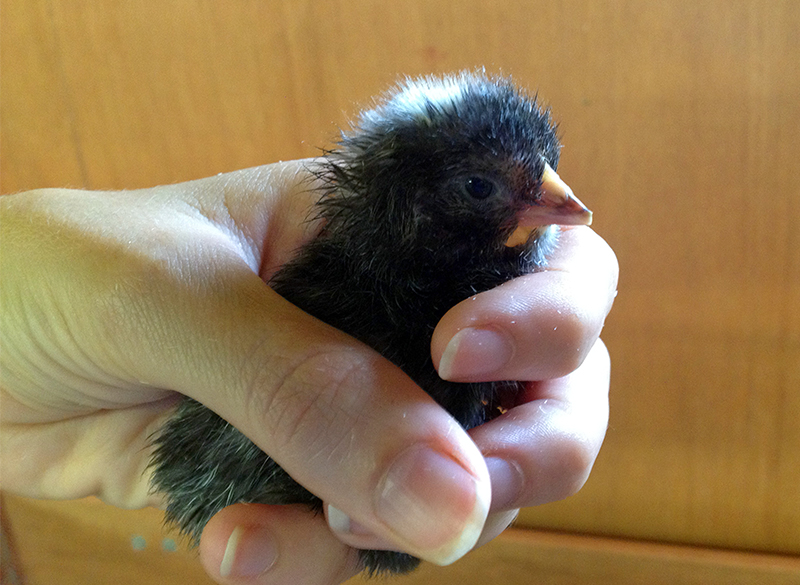
Just-hatched Griz, still damp, July 2013
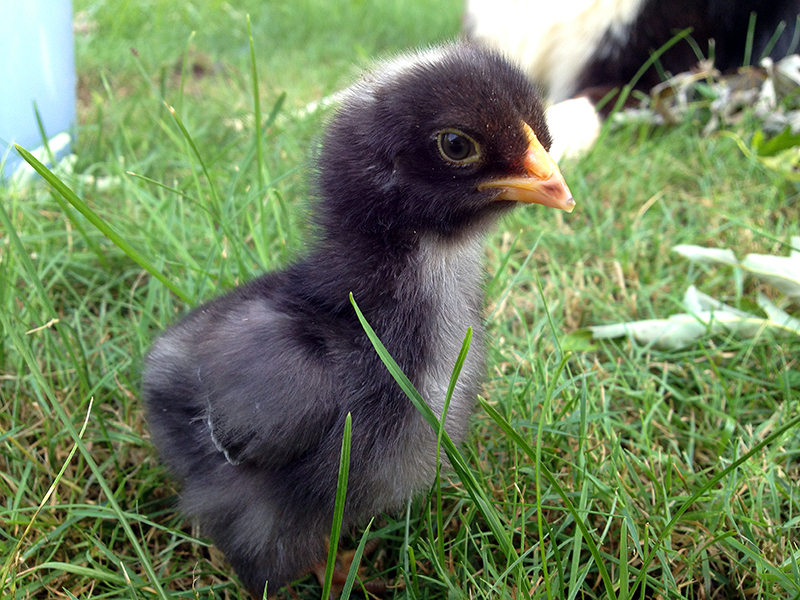
Griz at one week
March 1st, 2014 §
Last night I drank half a glass of wine and candled the 15 eggs I’d put under a newly broody hen Sunday. What, this isn’t your idea of a rocking Friday night?
Maybe not for most people, but for me candling eggs induces Christmas-morning excitement. There are few things cooler in this world than getting to peek into an intact egg, with nothing more than a flashlight, and see bright red veins, a beating blob of heart and small dark eye. It is a magic trick, a miracle, and all those other things that make me grateful to be along for this wild ride.
Out of fifteen eggs, eight were definitely on the road to becoming chicks. One egg was a big fat question mark, and I magnanimously returned it to the clutch. I suspected five eggs were infertile, and in the interest of self education I risked destroying embryos to crack the eggs into a white bowl to check. All five were totally clear. My instinct and eye must be getting sharper.
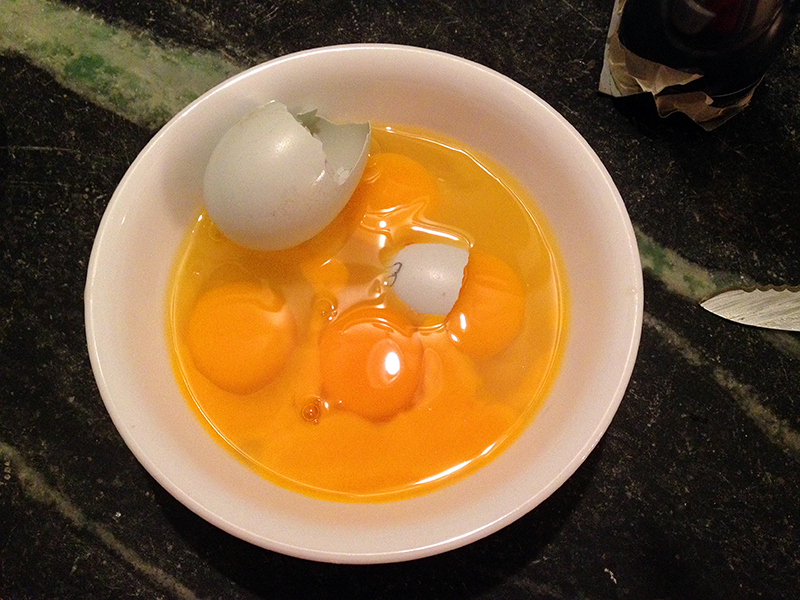
I didn’t take any photos of the developing eggs this time because I wanted them to be out in the cold air as little as possible. In fact, I withdrew them from under their mother two at a time, quickly candled them, and then snuggled them into a pan full of clean towels to hold their heat as much as possible. The whole operation was over in minutes. My pipes may have fallen victim to the polar vortex, but my potential chicks shouldn’t. If you want to see candling photos, they’re here.
I have high hopes for this hen as a broody. She’s one of last summer’s olive egger babies, and there’s a 50% chance she is Dahlia’s daughter. I only mention that because broodiness is a genetic trait. The young broody started plucking her breast feathers out a few weeks ago, and then hunkered down on all her flockmates’ eggs, hissing violently at any chicken that got too close. She’s the only broody out of the four I’ve had that’s actually pecked at me when I reached under her, and I take this feistiness as a good sign. I suppose I should name her as she’s definitely distinguishing herself.
I was on the fence about whether to do chicks again, but finally decided that it’s the best part of chicken keeping and costs me nothing. So I moved the broody to a coop in the garage, where she settled immediately despite being moved during the day, having a raucous rooster (Griz) in the coop next door, and me driving the loud and stinky tractor in and out right after the move. She remained steadfast, I set the eggs, and here we are.
I placed four eggs from my Coronation Sussex, two from last year’s olive egger babies, and nine Wheaten Ameraucana eggs from Cora under the hen. I removed all four of the Coronation eggs tonight, which were all infertile, and one Wheaten Ameraucana egg that was one of the oldest I placed, and had also cycled through the refrigerator as I waffled. I find it telling that my Coronation Sussex hen is the only bird that still has luxuriant feathers on her back and all her eggs were infertile. The hens that laid the fertile eggs are all looking a bit sparse back there because of Calabrese’s attentions. Another lesson learned—keep an eye out for “favorite” hens when scouting future mothers.
I just read back through last summer’s pained posts on hatching eggs, and I have to say that after that experience and this, I will never again let a hen set eggs in the middle of the summer. I realize now that the heat was really detrimental, leading to spoiled eggs that burst and contaminated the nest, and to chicks that were born prematurely and deformed. Incubating in the winter is the way to go. Live and learn.
But then again, we’re only five days into the 21-day incubation period, so let’s not count our chicks before they hatch, right?
December 6th, 2013 §
Another olive egger pullet has come online. Yesterday I got two olive pullet eggs, and I figured out that their mother Dahlia is responsible for the big brown egg. She’s setting a good example!

These little olive eggs are so amazing. They’re like the eggs of some exotic species. And today I got one more! The pullets are twenty-one weeks old this week. Eventually the pullets should produce full-size eggs—these are just their starter eggs. Thus I am especially appreciating them because I know they are a fleeting phenomenon.
Something I never knew before I had chickens is that a hen will consistently lay eggs of basically the same shape and color, with the same amount of speckling. If you pay attention, this makes it easy to know which bird is laying which eggs, and how often, and gives you a good idea of a particular hen’s productivity. For example, I can tell from looking at the photo above that different pullets are laying the olive eggs, even if I didn’t know they were both laid on the same day, as one egg is browner with speckles, and the other is a clear, lighter olive. And the first egg I got this week was laid by the pullet that produces speckled olive eggs.
December 3rd, 2013 §
I had a completely unexpected surprise today as I was feeding the chickens. I glanced into their nest box and saw this:

Ever since the girls quit laying for the winter—many weeks ago—I’d stopped checking their nest box for eggs. But it turns out that even without any supplemental light, and headed into the darkest days of winter, at least two chickens are making an effort. One, laying the large brown egg, is either Dahlia or her Black Copper Marans sister. And the other laying chicken is a homegrown olive egger pullet, which is a total surprise as the chicks were born so late this summer that I hadn’t expected any of the four young pullets to lay before next spring.

This little olive pullet egg is the first egg from a chicken born and raised right here on Bonafide Farm. She’s a second-generation Bonafide bird, and a science experiment begun two years ago when I raised her Wheaten Ameraucana (blue egg-laying) and Black Copper Marans (dark brown egg-laying) parents with the hope that their genes would combine to produce a chicken that lays an olive egg.
And today, with this first beautiful olive pullet egg, I can claim success. Well, as much as one can having not actually laid the egg myself!
For more on how this pullet came to be, head on back to July 2013…
July 26th, 2013 §
I had a lightbulb moment today when I realized that there was a way I could use my chickens to control insects in the garden…without sacrificing my plants or produce. I’ve been wanting to let the pest-eating power of my chickens loose in the garden, with hopes that they would attack the harlequin bugs on my kale, and the Mexican bean beetles on my beans. But, of course, when I let the flock in for a trial run they went right to my ripest tomatoes and dug in. They got a few good mouthfuls before I chased them out, and on their way they scratched the heck out of some smaller plants.
I’ve read that some people use bantams (mini chickens) in their gardens to limit the destruction from scratching, and yet other people suggest that Silkie chickens, which have feathered feet, are gentler as they scratch. I’m lacking in the bantam and Silkie departments, but I do have some very mini chickens of my own—the chicks! I knew that with their tiny size they’d be gentler on the plants than the full-grown birds, and being growing babies their appetites just don’t end.
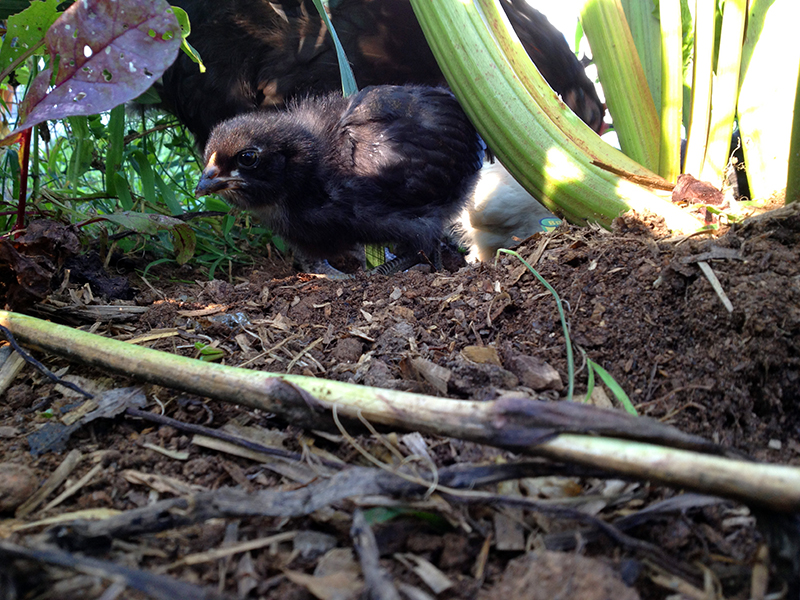
Of course I’d still have to keep the chicks, and their mother, away from the tomatoes. I erected a hasty barricade from a couple of pieces of chicken wire held to the garden posts with zip ties, and then went to fetch my arsenal from the broody coop in the garage.
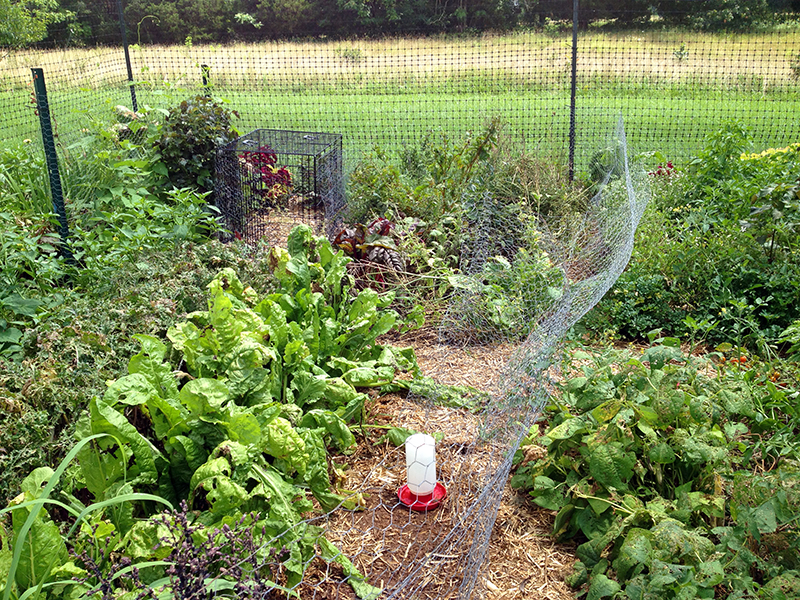
Dahlia’s relief was palpable when I released her into the fenced-off garden section. After a month and a half of living in small coops, and with half a dozen busy babies, I could tell she was dying for some room to stretch her wings. She scratched in the straw, and then lay down to luxuriate in the cool soil with the hot sun on her wings. Two of her chicks immediately imitated her basking behavior, which almost made me fall over from the cuteness.
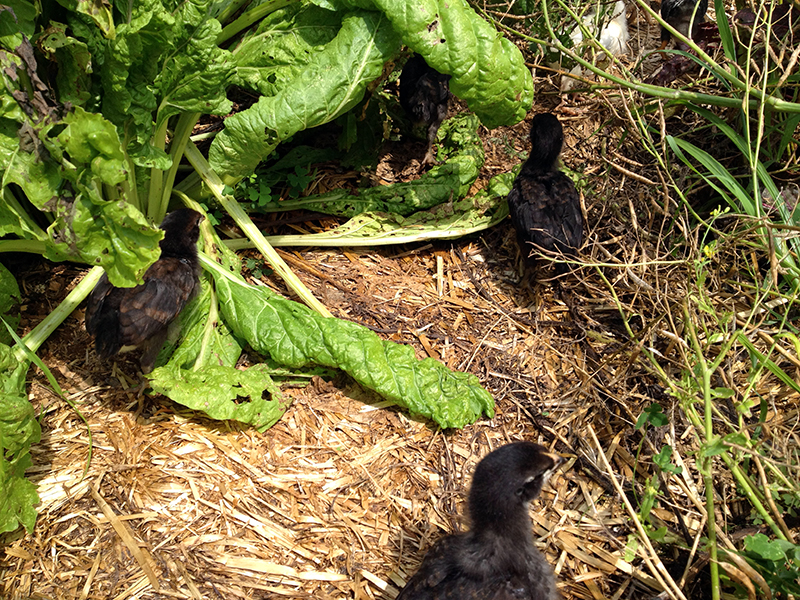
Dahlia and her six chicks spent about eight hours in the garden today. Each time I checked on them they were busy scratching and searching for bugs, sticking close to Mom. They spent a long time under the pest-infested kale, which was great to see. The rest of the flock even came around for introductions, which I hope will help ease things when these babies need to join the adults. After only raising chicks in brooders, it’s a real treat to see natural chicken rearing in action.
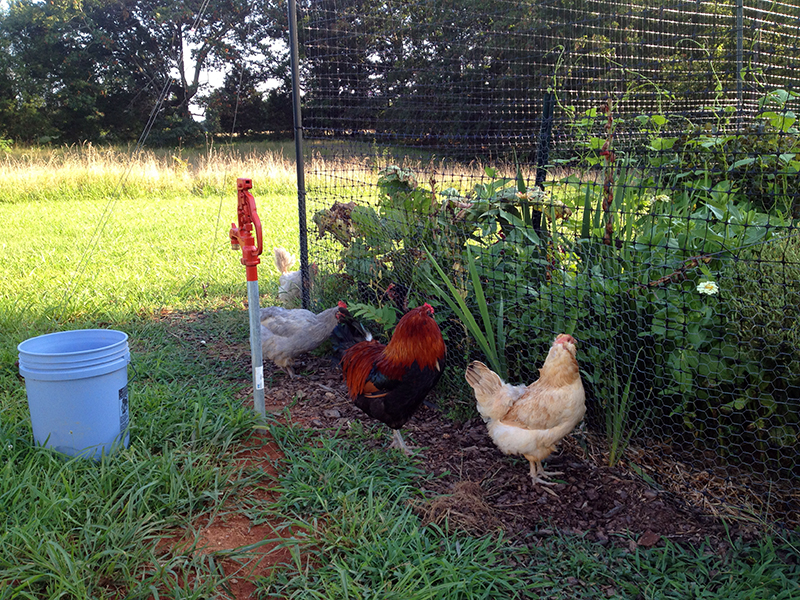
Around sundown it was time to collect the family to return them to the safety of the garage for night. Now this was a hilarous undertaking. I am glad that the only creature around to witness was my dog, and he didn’t judge. I prowled amongst the vegetation, grabbing chicks. I put the chicks in to a five-gallon bucket to carry them back to the garage, but of course they’re now big enough that they easily fly up to the lip of the bucket and jump out. Each time I’d catch and add a chick, one would fly out and go running for its mother. It was a ridiculous chick chase, soundtracked by Dahlia clucking in concern as each baby was lifted airborne.
Eventually I got all the babies corralled and Dahlia tucked under my arm for our journey home. An ungraceful ending notwithstanding, I think it was a good day out of the chicks, and a big help for the garden.
July 24th, 2013 §
The chicks are growing by the hour, and their new trick is to jump on Dahlia’s back and ride around a bit before sliding/flying off. She is amazingly patient with these constant assaults, which are probably way more cute to me than they are to her.
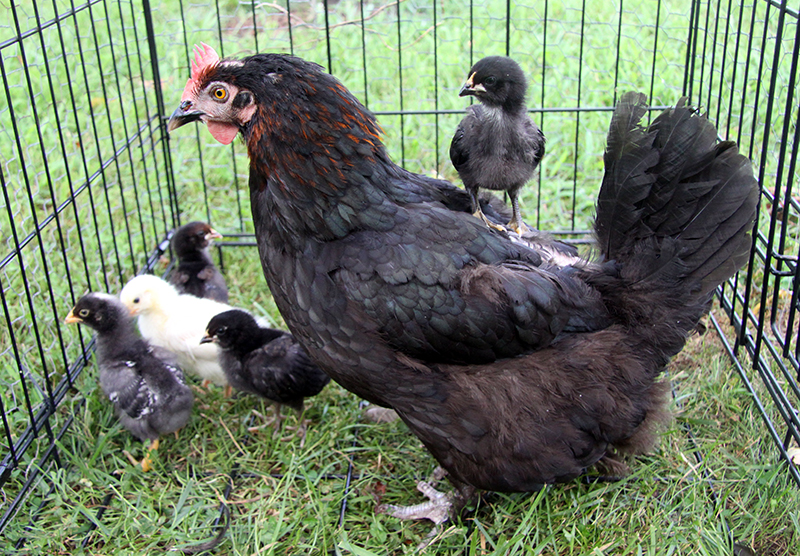



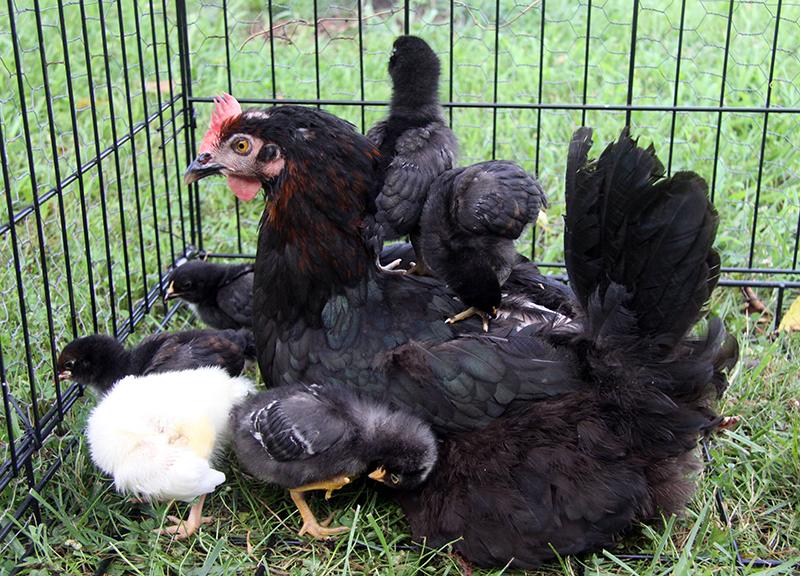
All this action shows me the chicks are ready for new adventures. On Saturday night I wrapped Tuckers’ puppy crate in chicken wire to make an escape-proof pen, and took the chicks outside for their first real exposure to grass and dirt. I’ve had then out every evening for a bit, and it’s neat to watch them learn how to scratch, hunt bugs, and eat clover. It’s amazing how much the chicks change and grow from day to day. Just two weeks old and they’re well on their way to being big chickens.
July 16th, 2013 §
Enough of bloody flock power struggles. Let’s talk about the happy family living in the broody coop in the garage. Dahlia is a very calm and patient mother, and protective. She flew out of the coop last night when I took one of her chicks out to hold and she heard its distress cries. She’s doing a great job with her six chicks. They’re growing and changing by the day, and are already feathering out. It’s exciting to see a lot of copper brown in the new feathers of the black olive-egger chicks.
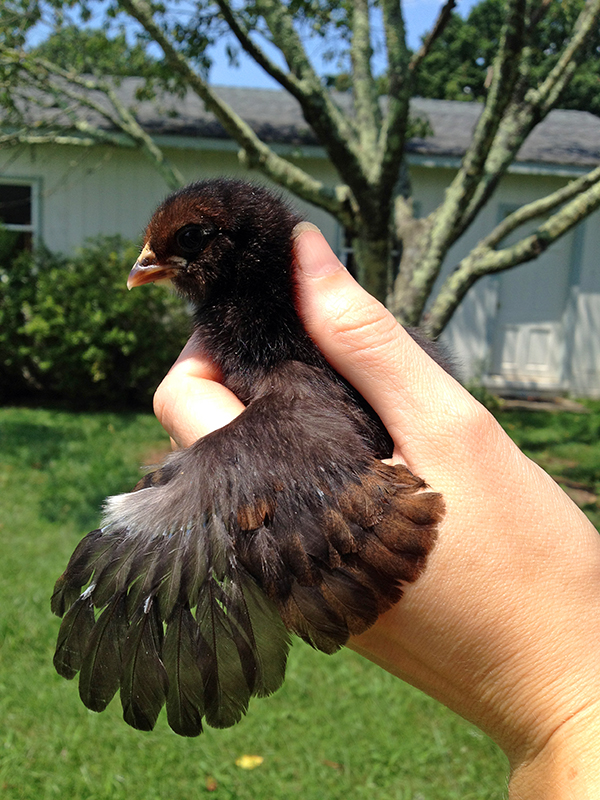
I am not sure if they will be any indication of the final coloration of the birds as adults, as coloration changes each time the chick molts. But it would be neat to have some brown hens—I don’t have any in the flock now.
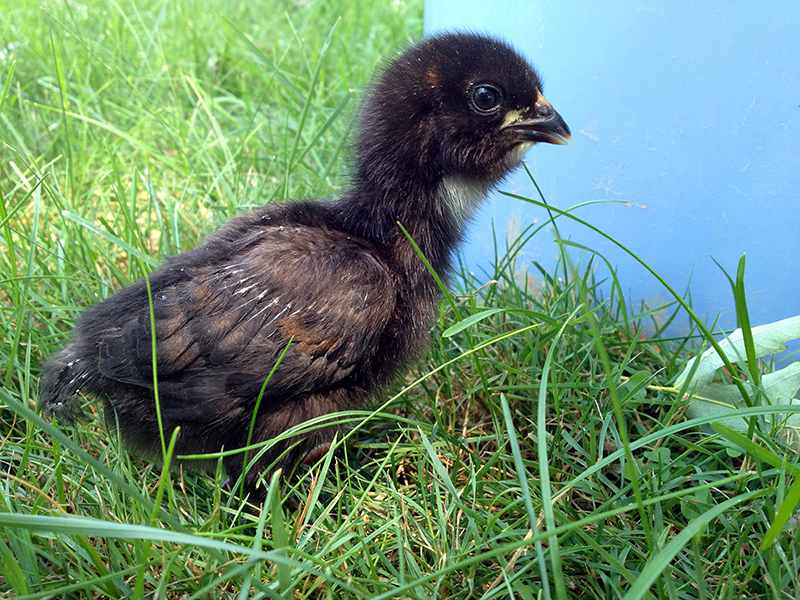
Some of the chicks still have their dried up umbilical cords attached. I never knew birds had umbilical cords until I saw them on the guineas that Iris hatched out last summer.
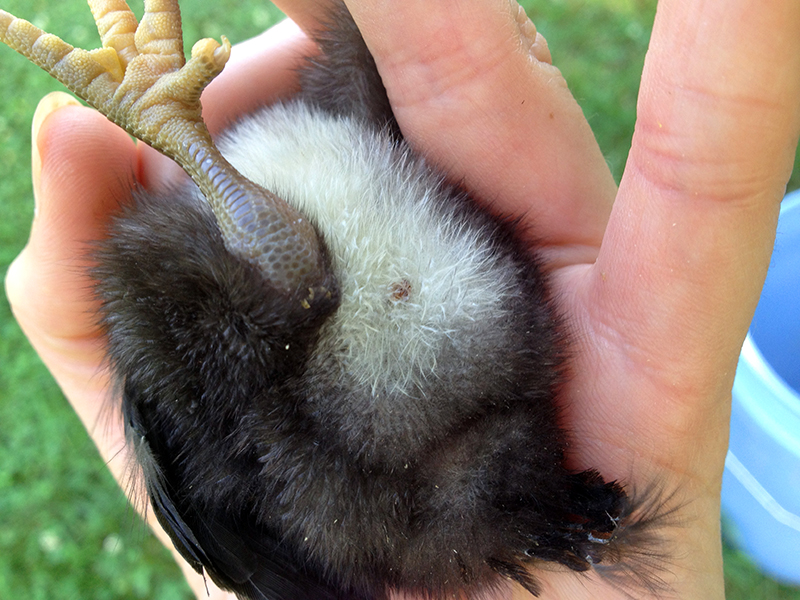
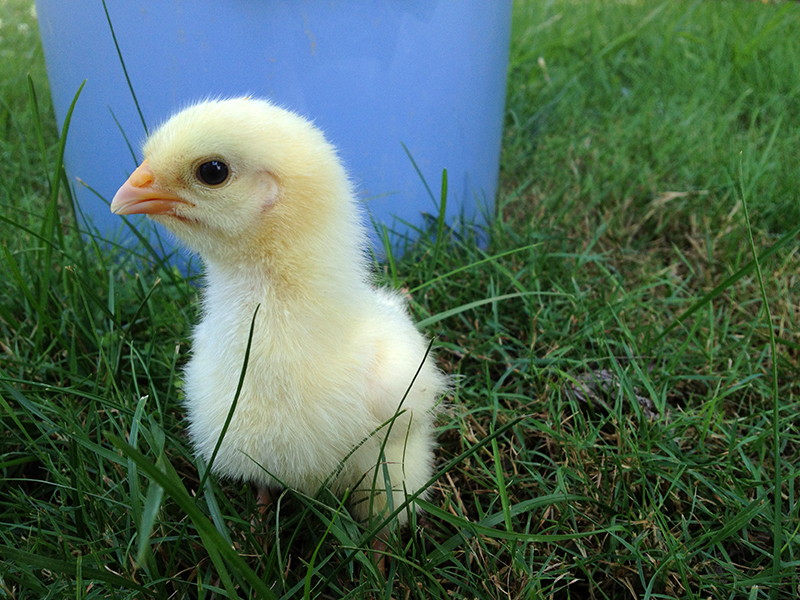
Here’s the sole Coronation Sussex chick. My $20 chicken (six hatching eggs cost $20, and this is the only bird I got out of them). Thankfully these birds are rare enough around here that if it’s a cockerel I should be able to sell him for at least $20.

This is Griz, the only chick out of my barred olive egger Oregano and the chick whose egg survived car trips and refrigeration at my brother’s house. I let my brother name the chick. He picked Grizabella, but when the chick was born a boy the name got shortened to something more masculine. The white barring is just starting to show on his wing tips, and he’s got a bit of copper color to his head (which makes me think this coloration traveled in on my Wheaten Ameraucana rooster’s genes, as the black chicks have it too). But who knows!!? The neatest thing about making these breed crosses is seeing what they turn out to look like.
June 28th, 2013 §
Today marks the halfway point in the incubation of the chicken eggs. It’s been ten days since I placed them under the hens, and my most respected chicken resource states that eggs incubated under broodies usually hatch in twenty days instead of the 21 days for mechanically incubated eggs. We shall see. As it is things aren’t looking awesome in the brood coops, and my confidence in the viability of these hatches is waning.
One of the eggs in Oregano’s coop was broken when I checked earlier in the week, and then yesterday I found the broken shell of a Coronation Sussex egg—the prettiest one of the bunch. Boo.
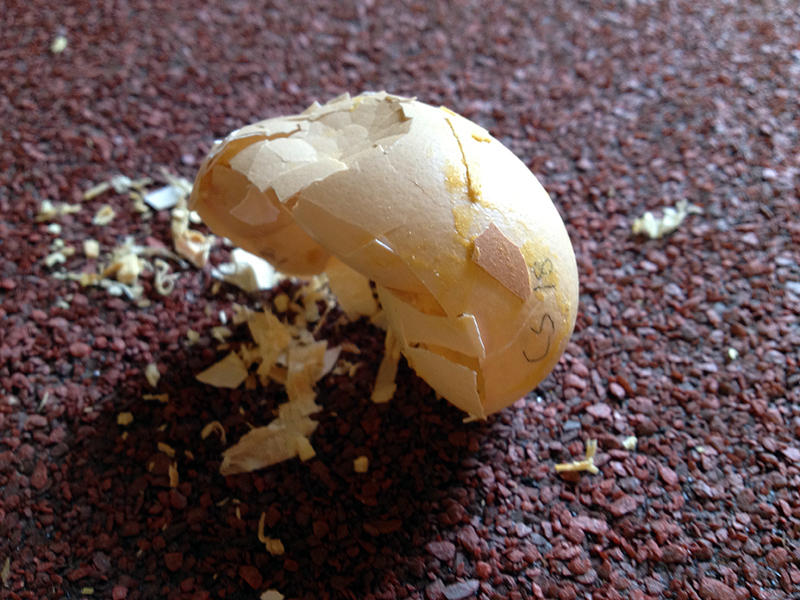
I don’t know if they are breaking on their own because they are rotten or if she’s cracking (and possibly eating) them. That nest box didn’t smell horribly of rotten egg, so I suspect the egg was fertile when broken. However, I don’t know how many days it would take under the hen for an infertile egg to spoil. So that’s the situation in Oregano’s coop. She’s been getting off the nest, as evidenced by her “deposits” in the cage, and has lost a lot of weight already. Broody hens generally don’t eat much while sitting, and if they do get off the nest their poo has such a strange and horrible smell that it’s enough to gag you just walking into a room with it. Needless to say I remove it as soon as it’s discovered, to keep flies off it and to get it out of my life and into the compost pile.
Over in Dahlia’s coop, I found a major mess in her nest box. One of the olive egger eggs placed under her was broken, and it had made a horrid fermented/cooked mess in the nest. At least five of the ten remaining eggs were coated in dried egg goo. Not good, for several reasons. The incubating egg is a living vessel, and its shell needs to be clean to allow air to pass in to the developing embryo. To seal the pores of the egg could suffocate the embryo.
I was at a loss as to what do. I know the embryos need air, but I also know that to wash an egg is to remove its “bloom” or protective covering that helps keep bacteria out of the egg. In this case, though, I figured washing was probably the lesser of two evil decisions, so I gently scrubbed the dried egg off the dirty eggs.
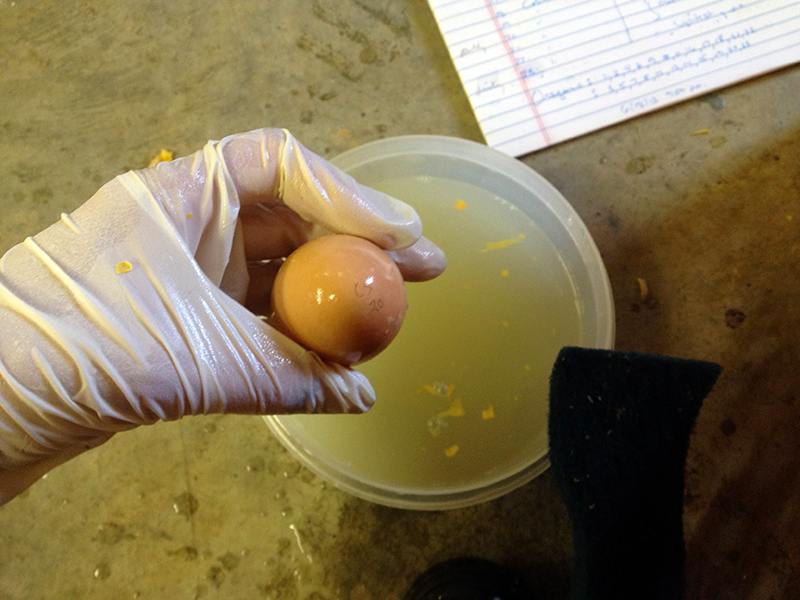
Oregano had a few dirty eggs too, so I touched those up as well, trying to just wash the dirtiest areas. Then I cleaned out Dahlia’s stinking messy nest, filling it with clean pine shavings. I made notes in my log of which eggs I washed, which may be telling around hatch day.
Of course I started this project before suiting up with gloves, and the stink that was on those eggs was so strong I couldn’t get it off my fingers all night despite multiple scrubbings and soaking in lemon juice. In all, it was a fittingly disgusting ending to an evening that began by killing a black widow in the crawlspace. Ugh.
Tonight it was time to candle the eggs, which means I shine a light through them to see if they are developing into chicks. I made a candler out of a MagLight flashlight (with fresh batteries) topped by a taped-on piece of cardboard to concentrate the beam and cushion the eggs.
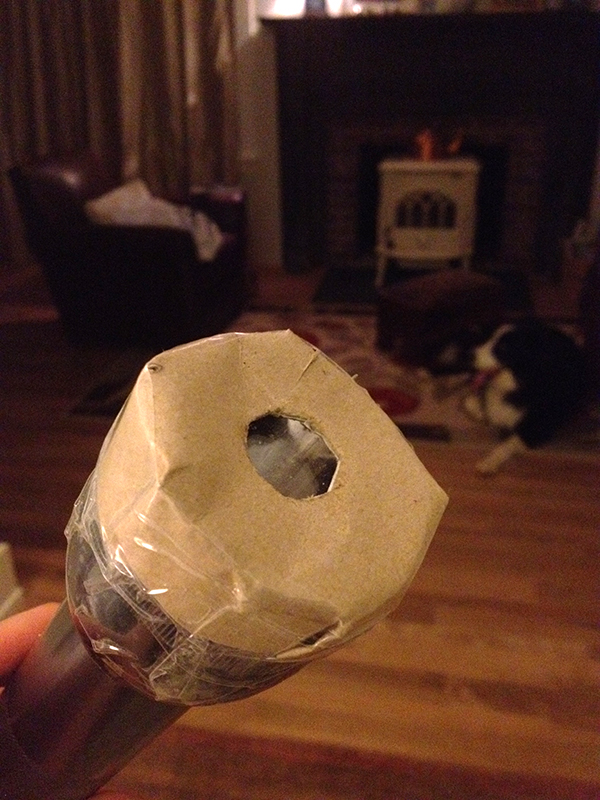
Then after dark I headed out to the garage to candle the eggs. All I needed was my candler, my record log and pencil, and a small dish to hold the eggs as I pulled them from the nest. I waited for the garage door lights to go off and began with Oregano’s eggs.
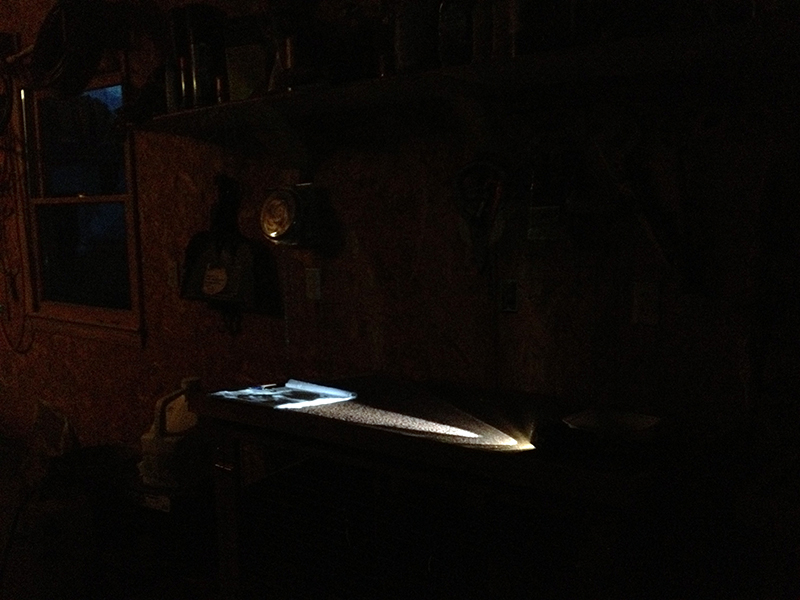
I removed each egg from under Oregano, enduring a peck on the wrist each time, bless her. I held the egg over the end of the candler, turning it until I could see something, or nothing. Most eggs looked like this, below, with some murky shape with no clearly defined blood vessels but perhaps the hint of a developing eye. Perhaps because many of them are Black Copper Marans eggs, which are dark to begin with and thus more difficult to candle.You can clearly see the air sack at the bottom of the egg.
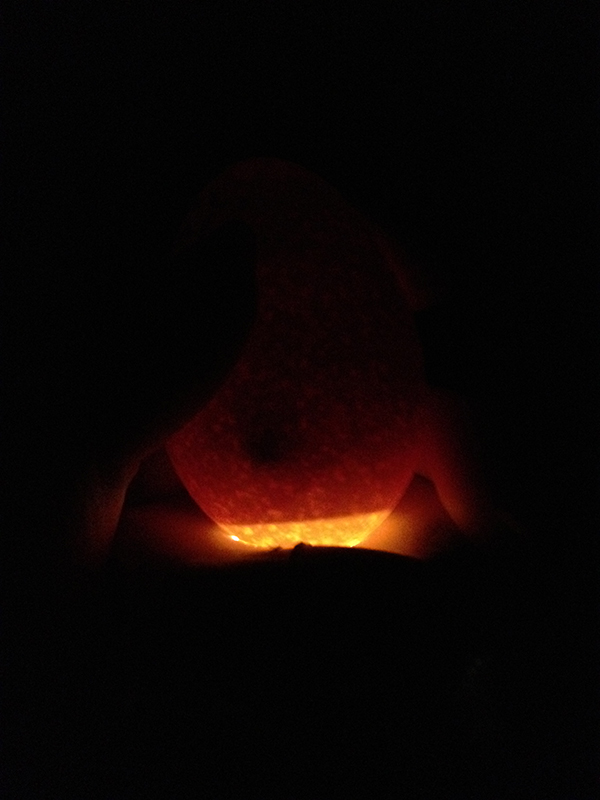
Here’s an egg in which you can see some veins and perhaps a developing eye, right on the line between shadow and light.
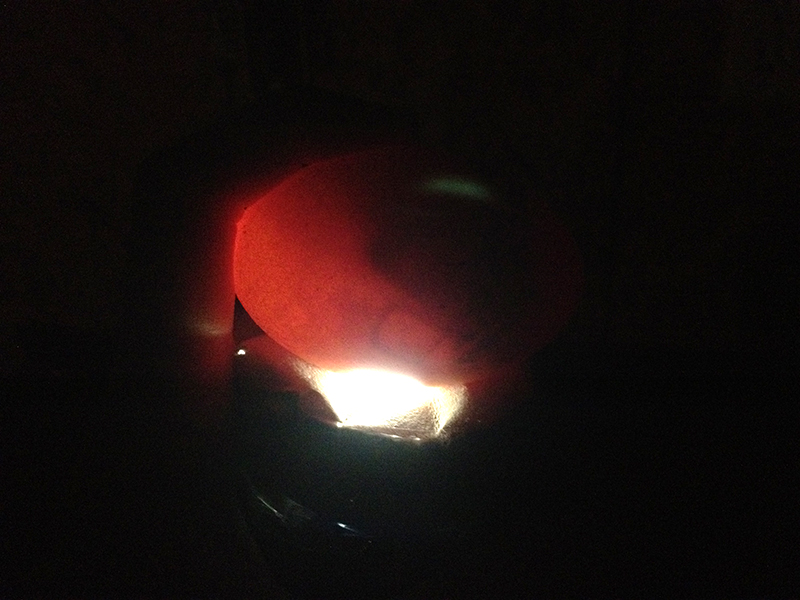
Here’s an egg, unfortunately one of the two remaining olive egger (Oregano’s) eggs, that I think has no development:
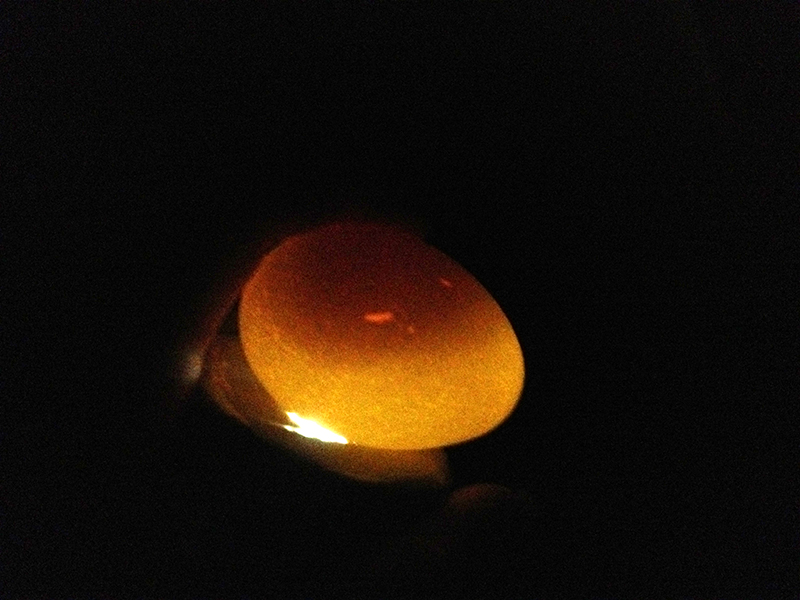
Here’s a Black Copper Marans egg that appeared very porous. This porosity is thought to be an indication of a poor egg for hatching.
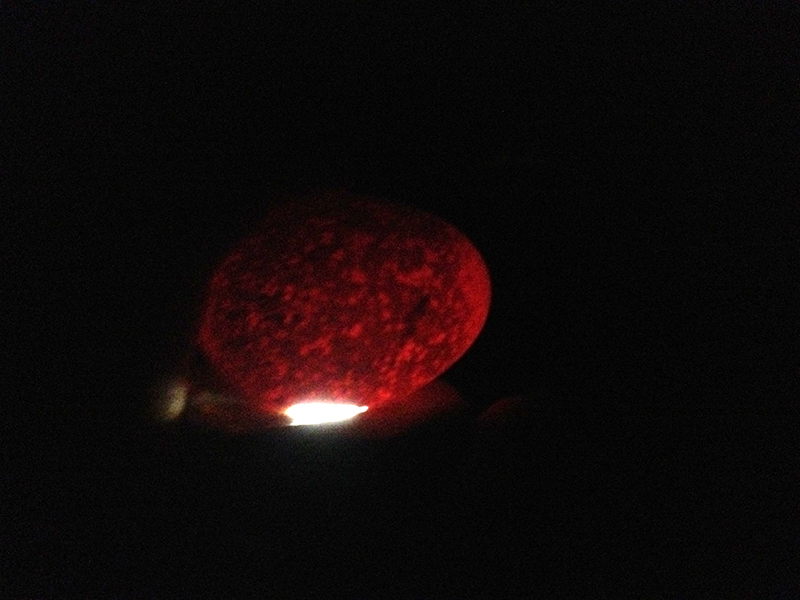
The clearest picture came from the last egg I candled, a Coronation Sussex under Dahlia. You can definitely see a healthy pattern of veins, and as I watched, I could even see the embryo moving within the shell.
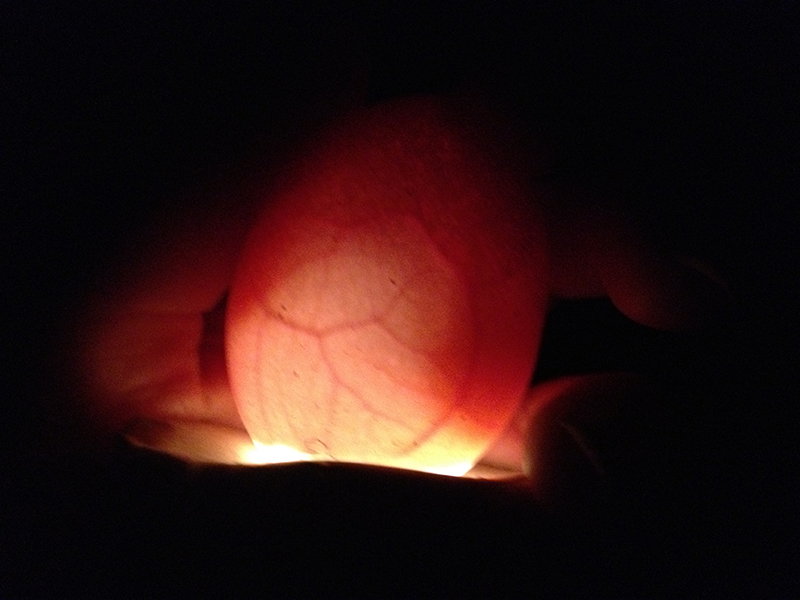
I have to admit that holding this egg in my hand, in the dark, and seeing those veins pulse is a pretty freaking incredible feeling. It’s scary, to hold such perfectly planned beauty alive within that fragile shell.
Out of the 20 remaining eggs, there is only one (the olive egger) that I feel I can conclusively describe as not developing. The rest are big question marks, and I am not yet experienced enough to discard any eggs based on my judgement. I feel better about the clutch under Dahlia, my Black Copper Marans, than the clutch under Oregano, my olive egger. But that’s just a hunch. So they will all stay put in the nest, and we will wait the ten more days to see what becomes of them. As you can already tell, a lot can happen in the next ten days. And so I remind myself, and you, dear reader: “Don’t count your chickens until they hatch.”





























